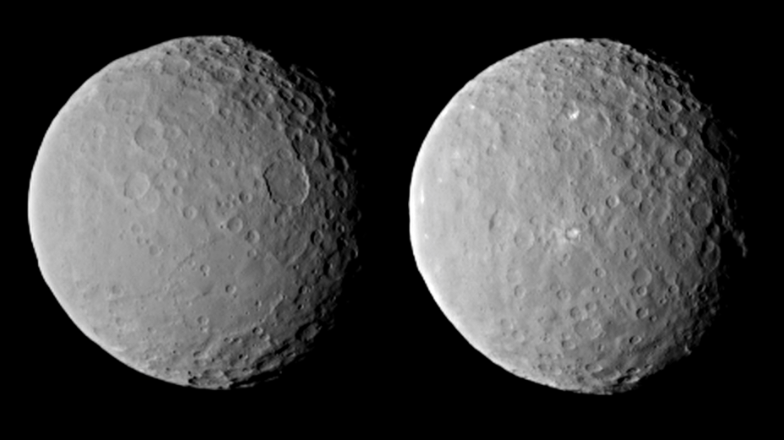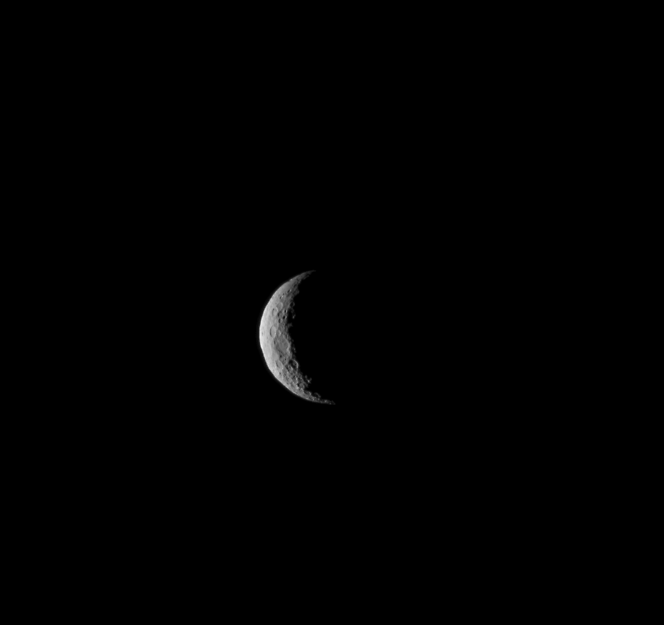[SatNews] Orbital ATK, Inc. (NYSE: OA) announced a major milestone in a deep space exploration mission aimed at uncovering the mysteries of the solar system. NASA's Dawn spacecraft has arrived at and is now orbiting the dwarf planet Ceres. Dawn, designed and built by Orbital ATK, accomplished this feat with the innovative use of solar electric ion propulsion, the world's most advanced and efficient space propulsion technology. Located in the main asteroid belt between Mars and Jupiter, Ceres is the largest unexplored world of the inner solar system. Now in its eighth year of a nearly nine-year-long mission, Dawn has already advanced human understanding of planetary formation by giant leaps with the data it has returned over the last four years.

Taken by NASA's Dawn spacecraft on February 19, 2015, these images capture the planetary body Ceres from a distance of about 29,000 miles (46,000 kilometers) Image Credit:  NASA/JPL-Caltech/UCLA/MPS/DLR/IDA
"Orbital ATK's flight-proven technology and extensive space systems experience played key roles in building the Dawn spacecraft and integrating the ion propulsion system provided by the Jet Propulsion Laboratory," said Frank Culbertson, president of Orbital ATK's Space Systems Group. "This technology is revolutionizing solar system exploration and made Dawn's historic journey to two planetary bodies possible. More than a decade ago, we committed to developing this spacecraft in an innovative way to assure that it was reliable and affordable. To see Dawn enter into this exciting science phase in fully functional status after seven and a half years and several billion miles of deep-space journey is a testament to the design and workmanship skills of the JPL/Orbital ATK team."
Launched from Cape Canaveral in September 2007, Dawn has been traveling toward Ceres since its September 2012 departure from Vesta, the second most massive object in the main asteroid belt and the first destination on this two-stop planetary mission. The spacecraft spent nearly 14 months orbiting and mapping Vesta, returning more than 30,000 images and other measurements of the protoplanet.

Ceres is seen from NASA's Dawn spacecraft on March 1, just a few days before the mission achieved orbit around the previously unexplored dwarf planet. The image was taken at a distance of about 30,000 miles (about 48,000 kilometers). Image Credit: NASA/JPL-Caltech/UCLA/MPS/DLR/IDA
Beginning in January, Dawn has returned increasingly sharper images of Ceres, showing a heavily cratered surface with multiple intriguing, bright features. Dawn's image quality now substantially exceeds the best available from the ground-based W.M. Keck Observatory and NASA's Hubble Space Telescope. By later this year, in its closest orbit around Ceres, Dawn will return images more than 800 times the resolution of Hubble. The images will provide mission scientists with a treasure trove of data to understand how Ceres evolved so differently from Vesta.
"The Dawn mission is the world's first chance to get an up-close look at two bodies which date back to the formation of the solar system, but evolved very differently," said Mike Miller, Orbital ATK vice president, Science and Environmental Programs, Civil and Defense Satellite Division. "Ceres is thought to contain substantial water, perhaps up to 27 percent of its mass, a quantity roughly equivalent to the fresh water on Earth. It is expected to be mostly in the form of ice, but there may also be a liquid subsurface ocean. Dawn's detailed image and compositional data will help us understand this very exciting prospect."
Orbital ATK's Space Systems Group designed and built Dawn at the company's facilities in Dulles, Virginia. Measuring 65 feet in length and weighing nearly 2,700 pounds at launch, Dawn incorporated features of Orbital ATK's Earth science and commercial communication spacecraft technology.
Dawn's mission is managed by the Jet Propulsion Laboratory for NASA's Science Mission Directorate in Washington. Dawn is a project of the directorate's Discovery Program, which is managed by NASA's Marshall Space Flight Center in Huntsville, Alabama. The University of California at Los Angeles (UCLA) is responsible for overall Dawn mission science. The German Aerospace Center, the Max Planck Institute for Solar System Research, the Italian Space Agency and the Italian National Astrophysical Institute are international partners on the mission team.

